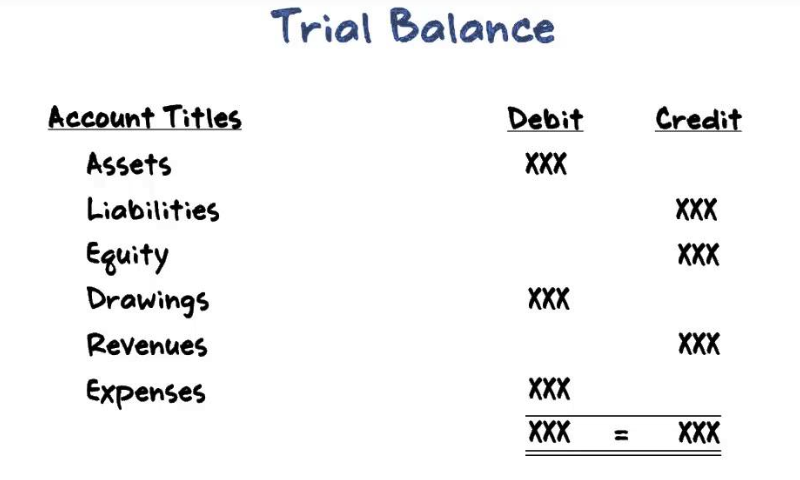Trial Balance methods: A trial balance is a schedule or list of debit and credit balances extracted from various accounts in the ledger including cash and bank balances from the cash book. Since every transaction has a dual effect i.e. every debit has a corresponding credit and vice versa, the total of the debit balances and credit balances extracted from the ledger must tally. Thus, at the end of the accounting period or the end of each month, the balances of the ledger accounts are extracted and a trial balance is prepared to test whether the total debits are equal to the total credits or not.
This follows from the fact that under the Double Entry System, the amount written on the debit sides of various accounts is always equal to the amounts entered on the credit sides of other accounts and vice versa. Hence the totals of the debit sides must be equal to the totals of the credit sides. Also total of the debit balances will be equal to the total of the credit balances.
Once this agreement is established, there is reasonable confidence that the accounting work is free from clerical errors, though is not proof of cent percent accuracy, because some errors of principle and compensating errors may remain. Generally, to check the arithmetic accuracy of accounts, a trial balance is prepared at monthly intervals. However, because the double entry system is followed, one can prepare a trial balance at any time. Must Check Petty Cash Book.
Though a trial balance can be prepared at any time it is preferable to prepare it at the end of the accounting year to ensure the arithmetic accuracy of all the accounts before the preparation of the financial statements. It may be noted that the trial balance is a statement and not an account.
Quick Links
Features of a Trial Balance
It is a statement prepared in a tabular form. It has two amount columns one for debit balances and the other for credit balances.
The balances at the end of the period as shown by ledger accounts are shown in the statement.
It can be prepared on any date provided accounts are balanced.
It is a method of verifying the arithmetical accuracy of entries made in the ledger.
Objectives of Preparing Trial Balance
(i) It is a check on the accuracy of posting. If the trial balance agrees it proves that:
- (a) the books are arithmetically accurate, and
- (b) both aspects of the transactions have been recorded in the books of original entry as well as in the ledger.
(ii) It brings together the balances of all the accounts in one place and this facilitates the preparation of final accounts and balance sheet. You may also like Rules of Debit and Credit.

Methods of Preparing the Trial Balance
(i) Totals Method: In this method, the totals of the debit and credit sides of the ledger accounts are shown in the trial balance. The sum totals of the debit and credit columns of the trial balance must be equal. This is a less popular method.
(ii) Balances Method: In this method, the balances of ledger accounts are taken to respective debit and credit columns of the trial balance and then grand totals are taken out. The total balances in the debit column must be equal to the total balances in the credit column of the trial balance.
Objectives of Preparing the Trial Balance
The preparation of the trial balance has the following objectives:
- (i) Trial balance enables one to establish whether the posting and other accounting processes have been carried out without committing arithmetical errors. In other words, the trial balance helps to establish the arithmetical accuracy of the books.
- (ii) Financial statements are normally prepared based on the agreed trial balance; otherwise, the work may be cumbersome. Preparation of financial statements, therefore, is the second objective.
- (iii) The trial balance serves as a summary of what is contained in the ledger; the ledger may have to be seen only when details are required in respect of an account
Limitations of Trial Balance
One should note that the agreement of Trial Balance is not conclusive proof of accuracy. In other words, despite the agreement of the trial balance some errors may remain. These may be of the following types:
- (i) Transaction has not been entered at all in the journal.
- (ii) A wrong amount has been written in both columns of the journal.
- (iii) A wrong account has been mentioned in the journal.
- (iv) An entry has not at all been posted in the ledger.
- (v) Entry is posted twice in the ledger.
Still, the preparation of the trial balance is very useful; without it, the preparation of the financial statement, the profit and loss account, and the balance sheet would be difficult. Must Check Basic earnings per share.







